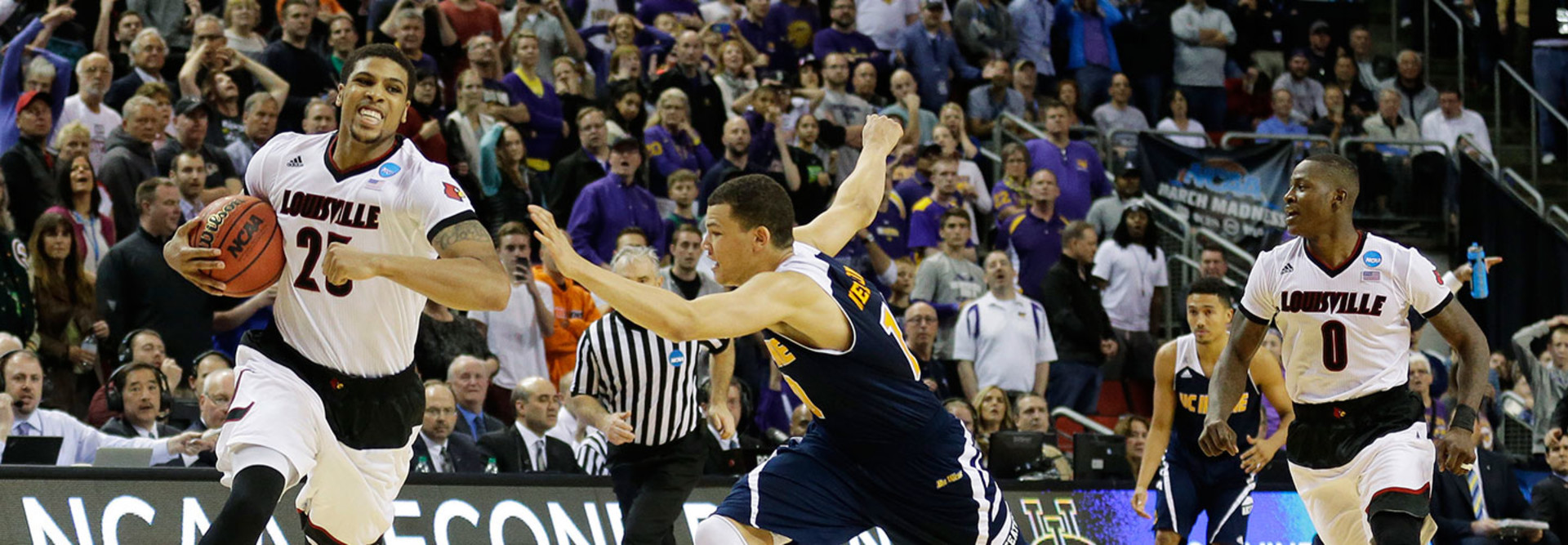How Louisville Used Video and Data Analytics to Navigate March Madness
When the University of Louisville defeated the University of Northern Iowa to advance to the Sweet 16, Doug Davenport didn’t spend much time savoring the victory.
Instead, on a cross-country flight home from Seattle the next morning, the Cardinals’ director of video operations flipped open his notebook computer and dived right into scouting the next opponents.
Because the next two rounds of games are scheduled for the same weekend, the team had to prepare for two games. While his assistant concentrated on the next game against North Carolina State, Davenport turned his attention to a potential Elite 8 matchup against either Michigan State or Oklahoma.
Davenport focused on Michigan State first. He checked statistics expert Ken Pomeroy’s website and reviewed a season’s worth of analytical data on the Spartans, including offensive rebound rates, turnover rates and the percentage of points the team gets from three-pointers, two-pointers and free throws. He also analyzed the offensive and defensive efficiencies of each player.
“I try to find strengths and weaknesses — what they do, who does it, who takes the most shots,” Davenport says. “It gives me an objective view, and it’s a great place to start before I start watching video.”
Afterward he reviewed previous Michigan State games. Typically, while preparing for an opponent, he watches eight to 10 games: the last five games played plus a few others where the opposition either lost or was up against a team whose style of play is similar to Louisville’s. He categorizes each play and charts some of his own stats, and as he does so he finds trends and tendencies — any tidbit of information that could help the Cardinals win.
Using scouting software, he writes up a full scouting report on the opponent and its players, mixes in relevant stats and pairs it with supporting video footage, so head coach Rick Pitino and his assistants can review and create a game plan. Davenport says the combination of video analysis and advanced data analytics is critical for Louisville’s players to prepare for teams they are unfamiliar with during the NCAA Tournament.
“I try to find anything on film that helps stop them on offense, what hurts them on defense and how to attack them,” he explains. “But you just can’t look at the video without the numbers or look at the numbers without the video. They work hand in hand.”
The Tools of the Data Analytics Trade
Davenport uses a desktop computer in the office and stores all the video on a server. When he travels for games, he relies on a notebook computer and two external hard drives for data backup.
“I constantly back up my work,” he says. “My entire livelihood is on my hard drives. It’s hundreds of hours of work.”
Besides Ken Pomeroy’s website, the basketball team also relies on Synergy Sports Technology, a video service that Davenport uses to download opponents’ games.
Before the NCAA Tournament brackets were announced on March 15, he and his colleagues went on a downloading frenzy to get a head start on scouting. They spent 10 days around-the-clock downloading games of all the teams they expected to make it into the tourney.
Before each tournament game, Davenport builds a video database featuring nine to 10 hours of video. With every play tagged in multiple categories, coaches, for example, can view every offensive play by an opponent against man-to-man, zone or press defenses, every two-point shot made inside the paint, or every drive or shot attempt by specific players.
“I watch a lot of basketball right now,” Davenport says. “I look at their favorite alignments when they inbound the ball, their pick-and-roll tendencies and if a certain player favors the left or right hand.”
Louisville won the Northern Iowa game thanks to the hot shooting of guard Terry Rozier, who scored 25 points, and a smothering defense that held Northern Iowa’s top scorer, Seth Tuttle, to 14 points on seven shot attempts.
While preparing for the game coaches noticed from video footage that Tuttle likes to score over his left shoulder in the post. “For the most part, our post players did a nice job keeping him away from it,” Davenport notes.
A SportVU of the Game
Louisville is also one of the early adopters in college basketball of STATS LLC’s SportVU player-tracking technology, which uses six video cameras to track and record every player and ball movement.
SportVU provides the team with another set of analytical data, such as running speed and running distance in a game, the number of passes per possession, how long players hold the ball before they pass or dribble, and how many points a team is scoring inside and outside the paint.
Louisville, which installed the SportVU technology in its arena two years ago, uses the data to analyze its own team and to confirm what the coaches already see in games.
“It mostly reaffirms things we already believe and provides an unbiased perspective that we can show to players,” Davenport says. “If we tell players that they’re not going to the glass enough, they may not believe us. But if we pull up data that out of 19 missed shots when a player is on the court, he only got to the designated area four or five times, then it’s easier to get through to players.”
SportVU will make a greater impact in college basketball when more teams, including entire conferences, adopt the technology. That way, every team can analyze its home and away games, allowing it to use the technology to scout its opponents, Davenport explains.
The End of the Road
Louisville, which won the NCAA Championship in 2013, beat North Carolina State last Friday but lost its next game, against Michigan State, on Sunday.
While the Cardinals’ March Madness run is over, it was a successful season in which the team made it to its fourth Sweet 16 in a row.
Overall, coach Pitino, who has won 52 NCAA Tournament games and two NCAA championships in his coaching career, is intrigued by data analytics, but he doesn’t exclusively rely on them to drive his decisions. They are more of a supplement to his coaching, Davenport says.
“Coach Pitino is a very intelligent man with a high IQ. He’s been coaching basketball for 40 years. If there is something relevant that comes up, I will say it, and he will pay attention,” he says. “But no stat I tell him will fundamentally change his approach to basketball. He’s a Hall of Famer for a reason.”
Want to learn more about how analytics is transforming college basketball? Read our story about Duke University's success with integrating performance data into its coaching program.









